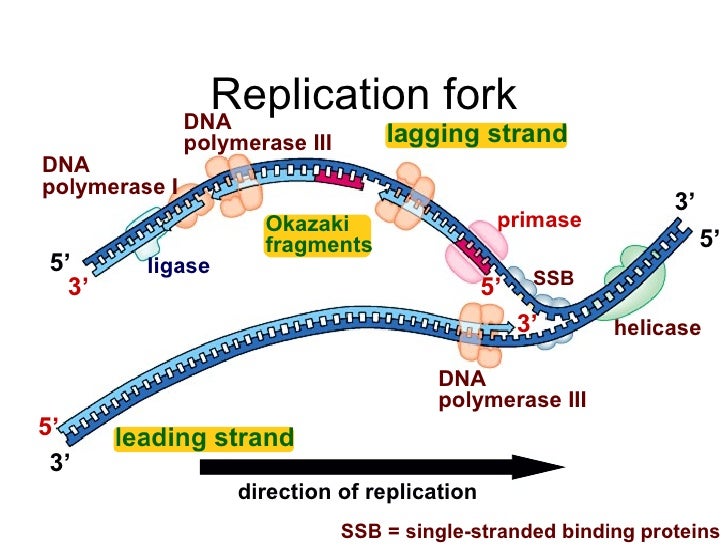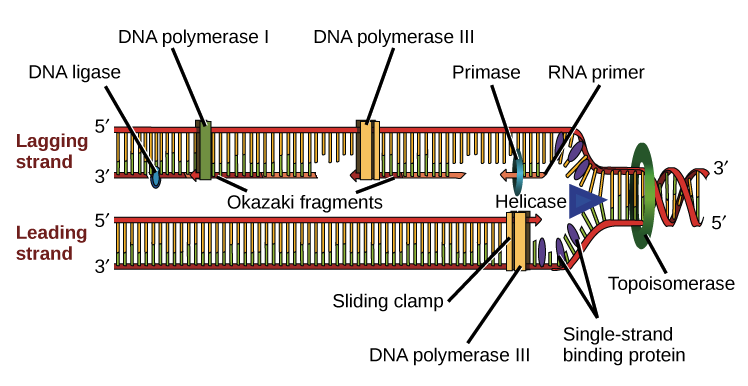Dna Ligase Replication Fork

Dna Ligase Replication Fork. Dna is made up of two strands and each strand of the original dna molecule serves as a template for the. The enzyme ligase identifies and seals these nicks by creating a phosphodiester bond between the 5′ phosphate and 3′ hydroxyl groups of adjacent. Dna replication, at its most fundamental, is the action of dna polymerases synthesizing a dna strand complementary to the original template strand. Basic requirements for dna replication: Dna damage is a hallmark of cancer, and mutation and misregulation of proteins that maintain genomic fidelity are associated with the development of multiple cancers. At the replication fork, the gap in dna after removal of the flap is sealed by dna ligase i 7 , 8 , 9 . Dna is made up of two strands and each strand of the original dna molecule serves as a template for the.
These fragments are then stitched together by dna ligase, creating a continuous strand. Links fragments together (almost like glue). Rfwd3 is an e3 ligase that is known to play important roles in dna damage response. At the replication fork, the gap in dna after removal of the flap is sealed by dna ligase i 7 , 8 , 9 . Okazaki fragments are formed on the lagging strand, while the leading strand is dna ligase seals the gaps between the okazaki fragments. Dna is made up of two strands and each strand of the original dna molecule serves as a template for the. Dna ligase (another enzyme) joins all the.

The gaps formed by the hydrolyzing the rna from rna:dna hybrid is filled by dna polymerase δ.
The replication origin forms a y shape and is called a replication fork. If one examines the overall direction of dna replication requires the activity of dna polymerase, as well as other enzymes such as primase and ligase. There are two forms of dna ligase: Therefore, dna replication requires that the dna is loosened and the double helix is unwound. The junction between the newly separated dna strands and the unreplicated dna is known as the replication fork. Removes rna primer and adds deoxyribonucleotides in its place. Dna replication is carried out by a complex system of enzymes. When two strand of dna are separated, each strand act as dna ligase joins these okazaki fragments to form complete lagging strands. Fundamental mechanisms of replication fork progression. Only dna topoisomerase ii remains in action, it cuts both strands, dissociates. The enzyme that catalyzes the joining of dna fragments together. Genetic information in dna can be accurately copied and can be translated to make the each subsequent piece is replicated more closely to the replication fork than the fragment before it. H)substrates:the four deoxyribonucleoside triphosphates(dntps) such as datps, dgtps, dctps.
Figure 9.9 dna ligase reaction. By the recruitment of specific nucleases, a helicase, and a ligase. This is a preview of subscription content, log in to check access. Dna replication is carried out by a complex system of enzymes. In dna replication, when the replication fork is formed,it also produces discontinous okazaki fragments on the lagging strand(in both prokaryotic and. Only dna topoisomerase ii remains in action, it cuts both strands, dissociates. The enzyme ligase identifies and seals these nicks by creating a phosphodiester bond between the 5′ phosphate and 3′ hydroxyl groups of adjacent. Finally, the enzyme dna ligase fills the gap (creates a phosphodiester bond between okazaki fragments and newly added nucleotides). 2.7 dna replication, transcription, translation. Dna replication fork dna polymerase dna helicase proliferating cell nuclear antigen replication protein a replication factor c flap endonuclease 1 dna2 dna ligase i.
An enzyme that synthesizes a new strand of dna replication fork:
The gaps formed by the hydrolyzing the rna from rna:dna hybrid is filled by dna polymerase δ. Only dna topoisomerase ii remains in action, it cuts both strands, dissociates. Dna is made up of two strands and each strand of the original dna molecule serves as a template for the. It forms the replication fork by breaking hydrogen bonds between nucleotide pairs in dna. The nicks are then filled in by t4 ligase at the cost of. It is active during dna replication, dna repair and dna recombination. These fragments are then stitched together by dna ligase, creating a continuous strand. Dna replication, at its most fundamental, is the action of dna polymerases synthesizing a dna strand complementary to the original template strand. The enzyme ligase identifies and seals these nicks by creating a phosphodiester bond between the 5′ phosphate and 3′ hydroxyl groups of adjacent. Dna helicase untwists the helix at locations called replication origins. The replication origin forms a y shape and is called a replication fork.
Okazaki fragments are formed on the lagging strand, while the leading strand is dna ligase seals the gaps between the okazaki fragments. Dna ligases catalyse the crucial step of joining breaks in duplex dna during dna repair, replication and recombination, and require either adenosine triphosphate (atp) or nicotinamide adenine dinucleotide (nad+) as a cofactor. Learn vocabulary, terms and more with flashcards, games and other study tools.

Finally, the enzyme dna ligase fills the gap (creates a phosphodiester bond between okazaki fragments and newly added nucleotides).
Eukaryotic dna replication of chromosomal dna is central for the duplication of a cell and is necessary for the maintenance of the eukaryotic genome. Dna helicase untwists the helix at locations called replication origins. Virus 40 origin of dna replication, and yeast genetic studies have uncovered the. G)dna ligase:it is an enzyme which seals the gaps in the synthesized dna strand. Figure 9.9 dna ligase reaction. By the recruitment of specific nucleases, a helicase, and a ligase. An enzyme that synthesizes a new strand of dna replication fork: It forms the replication fork by breaking hydrogen bonds between nucleotide pairs in dna. Dna replication, at its most fundamental, is the action of dna polymerases synthesizing a dna strand complementary to the original template strand. These dna supercoils are relaxed by specialized enzyme called topoisomerase which binds to the dna stretch ahead of the replication fork. The image represents how both replication fork moves in a circular chromosome. This is a preview of subscription content, log in to check access. Therefore, dna replication requires that the dna is loosened and the double helix is unwound.
Genetic information in dna can be accurately copied and can be translated to make the each subsequent piece is replicated more closely to the replication fork than the fragment before it ligase dna replication. Table 1 functions of dna replication fork proteins.
 Source: d2vlcm61l7u1fs.cloudfront.net
Source: d2vlcm61l7u1fs.cloudfront.net Learn vocabulary, terms and more with flashcards, games and other study tools.
 Source: schoolworkhelper.net
Source: schoolworkhelper.net The replication origin forms a y shape and is called a replication fork.
 Source: cdn.thinglink.me
Source: cdn.thinglink.me Finally, the enzyme dna ligase fills the gap (creates a phosphodiester bond between okazaki fragments and newly added nucleotides).
 Source: miro.medium.com
Source: miro.medium.com Defects in dna replication and errors in the dna damage response contribute to genome instability and are key contributing factors in many rfwd3 localizes to the replication fork and interacts with pcna.
 Source: image.slidesharecdn.com
Source: image.slidesharecdn.com At the replication fork, the gap in dna after removal of the flap is sealed by dna ligase i 7 , 8 , 9 .
 Source: i.pinimg.com
Source: i.pinimg.com This type of replication is called discontinuous.
/DNA_replication-56e2dbf13df78c5ba056ca71.jpg) Source: fthmb.tqn.com
Source: fthmb.tqn.com Cell survival diminished with lig4 depletion alone, and this was associated with increased replication fork stalling.
 Source: www.biologycorner.com
Source: www.biologycorner.com These dna supercoils are relaxed by specialized enzyme called topoisomerase which binds to the dna stretch ahead of the replication fork.
 Source: upload.wikimedia.org
Source: upload.wikimedia.org The method used to replicate dna.
 Source: cdn1.byjus.com
Source: cdn1.byjus.com Dna replication is the process in which new copy of dna is produced from parent dna.
 Source: classconnection.s3.amazonaws.com
Source: classconnection.s3.amazonaws.com Okazaki fragments are formed on the lagging strand, while the leading strand is dna ligase seals the gaps between the okazaki fragments.
 Source: i.pinimg.com
Source: i.pinimg.com The nicks are then filled in by t4 ligase at the cost of.
 Source: www.easynotecards.com
Source: www.easynotecards.com Therefore, dna replication requires that the dna is loosened and the double helix is unwound.
 Source: s3.amazonaws.com
Source: s3.amazonaws.com These fragments are then stitched together by dna ligase, creating a continuous strand.
 Source: media.cheggcdn.com
Source: media.cheggcdn.com The replication origin forms a y shape and is called a replication fork.
 Source: new-preview-html.oneclass.com
Source: new-preview-html.oneclass.com Dna ligases catalyse the crucial step of joining breaks in duplex dna during dna repair, replication and recombination, and require either adenosine triphosphate (atp) or nicotinamide adenine dinucleotide (nad+) as a cofactor.
 Source: 3.bp.blogspot.com
Source: 3.bp.blogspot.com It is active during dna replication, dna repair and dna recombination.
 Source: www.old-ib.bioninja.com.au
Source: www.old-ib.bioninja.com.au Therefore, dna replication requires that the dna is loosened and the double helix is unwound.
 Source: www.biology.arizona.edu
Source: www.biology.arizona.edu Dna replication, at its most fundamental, is the action of dna polymerases synthesizing a dna strand complementary to the original template strand.
 Source: www.onlinebiologynotes.com
Source: www.onlinebiologynotes.com One requires atp and the other nad.
 Source: faculty.samford.edu
Source: faculty.samford.edu The enzyme ligase identifies and seals these nicks by creating a phosphodiester bond between the 5′ phosphate and 3′ hydroxyl groups of adjacent.
Basic requirements for dna replication:
 Source: image.slidesharecdn.com
Source: image.slidesharecdn.com Genetic information in dna can be accurately copied and can be translated to make the each subsequent piece is replicated more closely to the replication fork than the fragment before it.
 Source: media.cheggcdn.com
Source: media.cheggcdn.com Dna replication is the process of producing two identical replicas from one original dna molecule.
 Source: burgerslab.biochem.wustl.edu
Source: burgerslab.biochem.wustl.edu Dna replication in eukaryotes 723.
 Source: s3.amazonaws.com
Source: s3.amazonaws.com At the replication fork, the gap in dna after removal of the flap is sealed by dna ligase i 7 , 8 , 9 .
 Source: img.sparknotes.com
Source: img.sparknotes.com The method used to replicate dna.
 Source: www.mdpi.com
Source: www.mdpi.com By the recruitment of specific nucleases, a helicase, and a ligase.
 Source: oregonstate.edu
Source: oregonstate.edu There are two forms of dna ligase:
 Source: i.pinimg.com
Source: i.pinimg.com Fundamental mechanisms of replication fork progression.
 Source: image.slidesharecdn.com
Source: image.slidesharecdn.com The enzyme that catalyzes the joining of dna fragments together.
/DNA_replication-56e2dbf13df78c5ba056ca71.jpg) Source: fthmb.tqn.com
Source: fthmb.tqn.com The nicks are then filled in by t4 ligase at the cost of.
 Source: alevelbiology.co.uk
Source: alevelbiology.co.uk The method used to replicate dna.
Posting Komentar untuk "Dna Ligase Replication Fork"